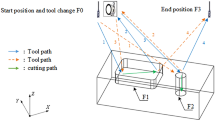Abstract
The geometric state of a workpiece is changing dynamically during the machining process. Such geometric changes lead to changes of the rigidity of workpiece features. Knowing the feature rigidity during the machining process is very crucial for the selection of right cutting parameters especially for aircraft structural parts with complex structures. This issue has rarely been addressed in the literature for cutting parameter optimization. In order to address this issue, an interim feature concept is introduced and the interim feature is modeled by using geometric information of final state and machining process information for aircraft structural parts. The interim feature rigidity is evaluated by simplifying the structures of interim feature. By considering the constraints of the interim feature rigidity, machine tool characteristics, and cutting tool performance, the cutting parameters are optimized using a genetic algorithm. A prototype system is developed based on the proposed approach, and a case study is performed. The experiment results show that the machining efficiency can be improved by 26 % after cutting parameter optimization, while the same machining quality is maintained.
Similar content being viewed by others
References
Byrne G, Dornfeld D, Denkena B (2003) Advancing cutting technology. CIRP Ann-Manuf Technol 52(2):483–507
Henriques E (2006) Towards the integration of process and production planning: an optimization model for cutting parameters. Int J Adv Manuf Technol 28(1–2):117–128
Adamczyk Z (2004) Integration concept of CAM system and tool diagnostic system in optimization of machining processes. J Mater Process Technol 157(2):8–15
Yusup N, Zain AM, Hashim SZM (2012) Evolutionary techniques in optimizing machining parameters: review and recent applications (2007–2011). Expert Syst Appl 39(10):9909–9927
Jing X, Li H, Wang J, Tian Y (2014) Modelling the cutting forces in micro-end-milling using a hybrid approach. Int J Adv Manuf Technol 73(9–12):1647–1656
Li ZZ, Zhang ZH, Zheng L (2004) Feedrate optimization for variant milling process based on cutting force prediction. Int J Adv Manuf Technol 24(7–8):541–552
Madić M, Radovanović M (2013) Modeling and analysis of correlations between cutting parameters and cutting force components in turning AISI 1043 steel using ANN. J Braz Soc Mech Sci Eng 35(2):111–121
Li Z, Liu Q, Ming X, Wang X, Dong Y (2014) Cutting force prediction and analytical solution of regenerative chatter stability for helical milling operation. Int J Adv Manuf Technol 73(1–4):433–442
Altintas Y, Budak E (1995) Analytical prediction of stability lobes in milling. Ann ClRP 44(1):357–362
Budak E, Altintas Y, Armarego EJA (1996) Prediction of milling force coefficients from orthogonal cutting data. Trans ASME 118:216–224
Budak E (2006) Analytical models for high performance milling. Part I: cutting forces, structural deformations and tolerance integrity. Int J Mach Tools Manuf 46(12):1478–1488
Karpat Y, Özel T (2007) Multi-objective optimization for turning processes using neural network modeling and dynamic-neighborhood particle swarm optimization. Int J Adv Manuf Technol 35(3–4):234–247
Ciurana J, Arias G, Ozel T (2009) Neural network modeling and particle swarm optimization (PSO) of process parameters in pulsed laser micromachining of hardened AISI H13 steel. Mater Manuf Process 24(3):358–368
Li L, Qiao F, Wu QD (2009) ACO-based multi-objective scheduling of parallel batch processing machines with advanced process control constraints. Int J Adv Manuf Technol 44(9–10):985–994
Solimanpur M, Ranjdoostfard F (2009) Optimisation of cutting parameters using a multi-objective genetic algorithm. Int J Prod Res 47(21):6019–6036
António CAC, Castro CF, Davim JP (2009) Optimisation of multi-pass cutting parameters in face-milling based on genetic search. Int J Adv Manuf Technol 44(11–12):1106–1115
Budak E, Tunç LT, Alan S, O¨zgu¨ven HN (2012) Prediction of workpiece dynamics and its effects on chatter stability in milling. CIRP Ann-Manuf Technol 61(1):339–342
Xu X, Wang L, Newman ST (2011) Computer-aided process planning—a critical review of recent developments and future trends. Int J Comput Integr Manuf 24(1):1–31
Li Y, Liu X, Gao XJ, Maropoulos PG (2012) A dynamic feature information model for integrated manufacturing planning and optimization. CIRP Ann Manuf Technol 61(1):167–170
Liu C, Li Y, Shen W (2014) Dynamic feature modelling for closed-loop machining process control of complex parts. Int J Comput Integr Manuf. doi:10.1080/0951192X.2014.900870
Li Y, Ding Y, Mou W, Guo H (2010) Feature recognition technology for aircraft structural parts based on a holistic attribute adjacency graph. Proc Inst Mech Eng B J Eng Manuf 224(2):271–278
Altintas Y (2000) Manufacturing automation: metal cutting mechanics, machine tool vibrations, and CNC design. Cambridge University Press, Cambridge
Author information
Authors and Affiliations
Corresponding author
Rights and permissions
About this article
Cite this article
Liu, C., Li, Y., Zhou, X. et al. Interim feature-based cutting parameter optimization for aircraft structural parts. Int J Adv Manuf Technol 77, 663–676 (2015). https://doi.org/10.1007/s00170-014-6487-y
Received:
Accepted:
Published:
Issue Date:
DOI: https://doi.org/10.1007/s00170-014-6487-y



